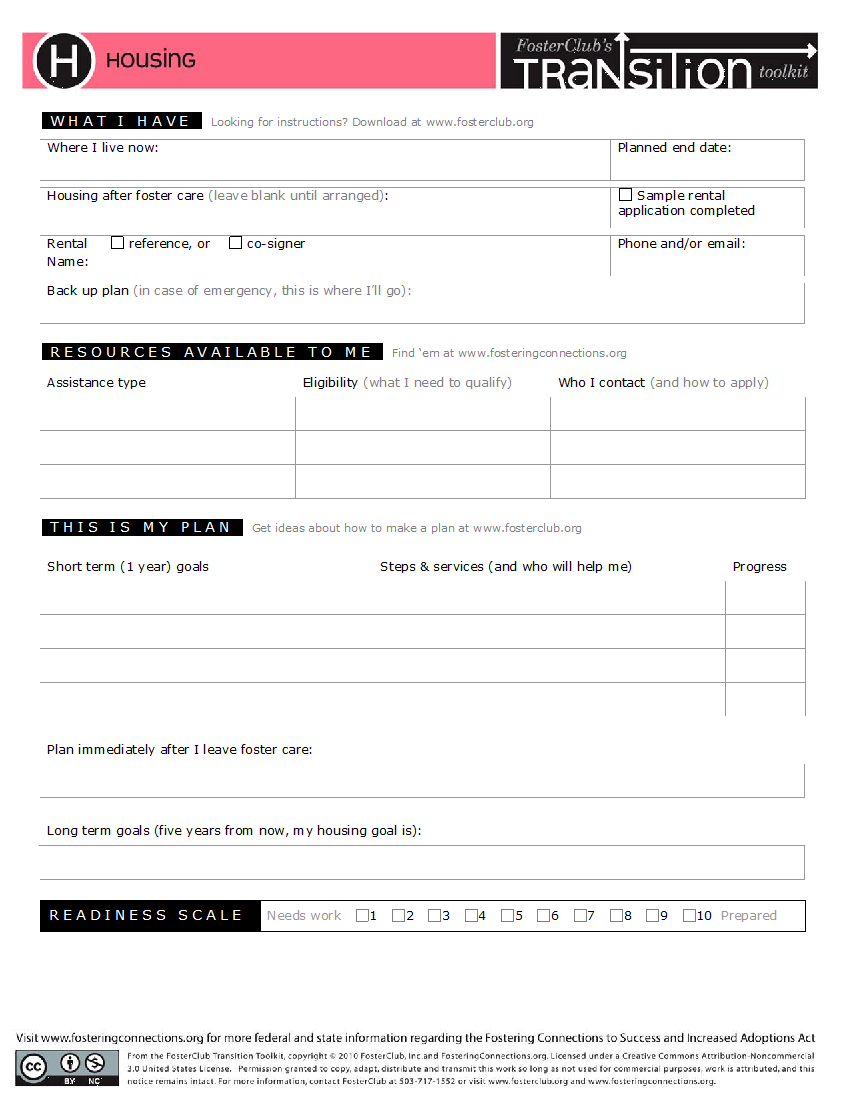

Gaining Independence
Getting a Job and Keeping It
Understanding Money and Credit
Accessing Supports and Resources
Accessing Supports and Resources
Many forms of income support and resources are available to young people who are transitioning from foster care to adulthood. Whether or not you decide to stay in foster care until you are age 21, you will continue to be eligible for county Independent Living Program (ILP) services to help you achieve self-sufficiency.
You can use this ILP Coordinators Contact List to find out who the ILP coordinator is in your county.
Extended Foster Care Option
Extended Foster Care gives you the option to remain in foster until age 21 so that you have a place to live while work on your transition goals, such as going to school, getting training, finding a job, and/or managing a medical condition.
If you decide to stay in foster care after you turn age 18, you will have three options for a place to live:
- You can continue to live in a foster home, group home, the home of a relative (except your biological parents) or family friend.
- You can live in transitional housing (THP+FC) with case management and support services—usually an apartment with a roommate.
- You can find a place on your own (Supervised Independent Living Placement) that is approved by your social worker.
Your social worker is required to assist you with this process. The information sheets below will help you to better understand your options.
Extended Foster Care for Current or Former Foster
This brochure details the rights, responsibilities, choices and benefits if you choose to stay in foster care after age 18. It also answers common questions about Extended Foster Care and provides lists of useful resources.
Re-Entry: Coming Back into Foster Care
This tip sheet is for former foster youth under age 21 who want to re-enter foster care and receive benefits under Extended Foster Care. Find out how to petition to court to re-open your case and to voluntarily re-enter foster care.
Housing Options in Extended Foster Care
This tip sheet for youth in extended foster care on how to obtain approved housing— including how to find an approved place on your own under a Supervised Independent Living Placement (SILP) as well as the Transitional Housing Placement Plus Foster Care (Care (or THP+FC) Program.
California THP+FC Programs
This is the current roster of organizations providing Transitional Housing Placement Plus Foster Care (THP+FC). The list is organized by county and includes the organizations housing models with a website link.
Mutual Agreement for Extended Foster Care
This is the official agreement you and your social worker must sign if you choose to stay in foster care after your 18th birthday.
Youth Housing Resources
Summaries and fact sheets of all housing programs for current and former foster youth
Transitional Housing for Former Foster Youth (Age 18-24)
If you are age 18-24 and no longer in foster care, you may receive housing support through the Transitional Housing Placement Plus (THP-Plus) Program. THP-Plus provides up to 24 months of affordable housing and supportive services, such as case management and vocational training to youth. Some counties have opted to provide transitional housing services for 36 months and up to age 25 if participants meet certain requirements. For more information on access services, including questions to ask housing program providers, see this THP-Plus website resources published by the John Burton Foundation.
California THP-Plus Programs
This is the most current roster of organizations providing THP-Plus programs. The list is organized by county and includes the organizations housing models with a website link..
How to Find and Rent Housing
Apartment Leasing
Two-page tip sheet for youth on what to expect when you lease your first apartment. Learn what to watch out for, covering costs, and what the lease should and shouldn’t include! From Know Before You Go Toolkit by the Alliance for Children’s Rights.
Young Adult’s Guide to Housing
This guidebook, published by the John Burton Foundation, is designed to help break down the process of finding housing into steps and to support you in your search. The guide is divided into five sections including, Budgeting for Housing, Housing Search, Applying for Housing, Getting Established, and Maintaining Housing. It also includes forms to make everything easier, including a budget worksheet, roommate questionnaire, and checklists for moving in and out.
Emergency and Temporary Housing
If you are at risk of becoming homeless and need emergency housing, you should always contact your child welfare agency to see if there are supports and services available to you. You may also be able to locate shelters or programs using the resources listed here.
- The Teen Project Shelter Finder
This organization aids teenagers aging out of the foster system by providing opportunities for higher education and independent living.
- ShelterListings.org
Visit ShelterListings.org for a state-by-state list of shelters and supportive housing near you.
- Runaway and Homeless Youth Programs
This Family and Youth Services Bureau website provides links to its programs, including street outreach, emergency shelters and longer-term transitional living and maternity group home programs for young people at risk of homelessness.
- HUD Youth Resources
Resources on youth homelessness are shared on the HUD site.
More Housing Resources
Privately Owned Subsidized Rental Housing (Project-Based Section 8)
HUD helps private apartment building owners offer reduced rent to low-income individuals and families through housing assistance programs. Some subsidized apartment buildings (often called ‘Family Buildings’) accept applications from low-income households headed by a person aged 18 or older through federal, state or local programs.
Youth Housing Voucher Program
The Family Unification Program is a specific housing choice voucher program for youth between 18 and 21 years old who left the foster care system at age 16 or older and who lack adequate housing. This program is limited to certain communities and there are a small number of vouchers available.
Housing Plan
Use this tool to help you keep track of your housing resources, options and needs, and to develop a housing plan as you transition into adulthood.

Other Supports
Government Entitlement Programs
County Resources
Accessing National, State, and Local Resources: A County Resources Guide
This county-by-county guide identifies housing, employment, physical and mental health, and education resources available to support foster youth transitioning into adulthood. Information needs updating but it provides a good resource for TAY looking for services independently.
Phones and Laptops
- Free Phones and Laptops
California LifeLine Program and iFoster.org are two programs that make free or low-cost phones and laptops available to foster youth. This fact sheet includes some references that are specific to Los Angeles County, as well as general information.
- California LifeLine Program
This is a direct link to the California LifeLife Program, which provides discounted cell phones and cell phone service to people living in California. Eligibility is based on enrollment in a public benefit program (Medi-Cal, School Lunch Program, others) or by meeting low-income threshold.
- iFoster.org
This is a direct link to the youth page of iFoster.org, which offers phones, laptops and digital lockers for foster youth and TAY.